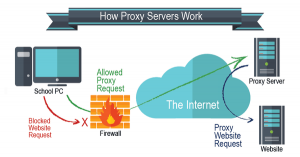Why Create Your Own Proxy Server
A proxy server acts as an intermediary between your device and the internet. It can provide a range of benefits, making it essential for various purposes. However, you might wonder why you should create your own proxy server instead of using a public one. Here are some key reasons:
- Enhanced Privacy and Security: One of the main advantages of having your own proxy server is the increased level of privacy and security it offers. By using a self-hosted proxy server, you have full control over who can access it. This means you can ensure that only trusted individuals or devices are allowed to connect, minimizing the risk of unauthorized access to your internet traffic.
- Faster Connection Speeds: Public proxy servers can sometimes be overcrowded and result in slow internet speeds. When you create your own proxy server, you have the advantage of dedicated resources. This means you can optimize the server’s configuration to meet your specific needs and enjoy faster connection speeds.
- Bypassing Geographical Restrictions: Many websites and online services implement geo-blocking, limiting access based on the user’s geographical location. By creating your own proxy server, you can choose its location and use it to bypass these restrictions. This is particularly useful for accessing region-restricted content or testing localized versions of websites.
- Content Filtering and Control: In certain environments, such as schools or workplaces, it may be necessary to implement content filtering to restrict access to certain websites or types of content. Creating your own proxy server allows you to easily configure content filtering rules and gain control over what can and cannot be accessed by users connected to the server.
- Customization and Flexibility: Using a public proxy server limits your options to the features and capabilities provided by the service provider. By creating your own proxy server, you have full control over its configuration and can customize it to suit your specific needs. Whether it’s implementing advanced security measures, adding logging capabilities, or integrating additional services, the possibilities are endless.
In summary, creating your own proxy server provides a multitude of benefits, including enhanced privacy, faster connection speeds, bypassing geographical restrictions, content filtering and control, and customization options. It gives you full control over your internet traffic, ensuring a secure and tailored browsing experience. So, if you value privacy, security, and customization, creating your own proxy server is definitely worth considering.
Choosing a Proxy Server Software
When it comes to creating your own proxy server, selecting the right proxy server software is crucial. There are numerous options available, each with its own set of features and capabilities. Here are some factors to consider when choosing a proxy server software:
- Compatibility: Ensure that the proxy server software is compatible with your operating system and network infrastructure. Whether you are using Windows, Linux, or macOS, make sure that the software you choose is compatible with your chosen platform.
- Protocol Support: Consider the protocols supported by the proxy server software. The most common protocol is HTTP, but if you require additional protocols like HTTPS or SOCKS, ensure that the software supports them.
- Scalability: Consider your needs for scalability. If you anticipate a growing number of users or an increase in traffic, choose a software that can handle the expected load efficiently. Look for features like load balancing and clustering to ensure proper scalability.
- Logging and Monitoring: Take into account the logging and monitoring capabilities of the proxy server software. It is important to track and analyze proxy server usage, monitor traffic patterns, and identify any suspicious activities. Look for software that offers comprehensive logging and reporting features.
- Security Features: Security is paramount when selecting a proxy server software. Look for features like encryption support, authentication mechanisms, and the ability to configure access controls. Ensure that the software provides robust security measures to protect your server and network.
- Ease of Use: Consider the user-friendliness of the proxy server software. Look for a software with a user-friendly interface and intuitive configuration options. This will make it easier for you to set up, manage, and troubleshoot your proxy server.
- Community and Support: Evaluate the community and support around the proxy server software. Look for software that has an active user community, forums, and documentation available. This ensures that you can easily find resources and seek help when needed.
In summary, when choosing a proxy server software, consider factors such as compatibility, protocol support, scalability, logging and monitoring capabilities, security features, ease of use, and community support. By carefully evaluating these factors, you can select the right software that meets your specific requirements and allows you to create a reliable and efficient proxy server.
Setting Up Your Own Proxy Server
Setting up your own proxy server requires a few essential steps. Here’s a general guide to help you get started:
- Choose Your Server: Decide whether you want to set up the proxy server on a dedicated physical machine or a virtual private server (VPS). Consider factors like hardware requirements, scalability, and budget when making this decision.
- Install Proxy Server Software: Select the proxy server software that aligns with your requirements and install it on your chosen server. Follow the software’s documentation or installation guide to ensure a smooth installation process.
- Configure Proxy Server: Once the software is installed, configure the proxy server settings. This involves setting the listening port, enabling or disabling protocols, defining access controls, and specifying any additional features and functionalities according to your needs.
- Set Up Network Configuration: Ensure that your server’s network configuration allows inbound and outbound connections to the proxy server. This may involve configuring firewall rules, port forwarding, or other network settings to ensure proper communication.
- Test Proxy Server: Test your proxy server by connecting to it from a client device. Configure the client device’s proxy settings to point to the IP address and port of your proxy server. Verify that the proxy server is functioning correctly by accessing websites or services through the proxy.
- Optimize Performance: Fine-tune your proxy server’s performance by adjusting settings like caching, connection limits, and bandwidth throttling. Monitor performance metrics and make necessary adjustments to ensure optimal performance for your intended usage.
- Implement Monitoring and Logging: Enable logging and monitoring features to track proxy server usage, monitor traffic patterns, and identify any issues or suspicious activities. Regularly review logs and reports to ensure the smooth operation of your proxy server.
In summary, setting up your own proxy server involves choosing the server platform, installing the proxy server software, configuring settings, setting up network configuration, testing functionality, optimizing performance, and implementing monitoring and logging. Pay attention to each step, ensuring proper configuration and testing to ensure a reliable and secure proxy server.
Configuring Proxy Server Settings
Configuring the settings of your proxy server is a critical step in ensuring its functionality and security. Here are some key settings to consider when configuring your proxy server:
- Listening Port: Specify the port on which the proxy server will listen for incoming connections. The default port for HTTP proxy servers is 8080, but you can choose any available port based on your requirements.
- Protocol Configuration: Determine which protocols your proxy server will support. Common protocols include HTTP, HTTPS, and SOCKS. Enable or disable these protocols based on your intended usage and the needs of your clients.
- Access Control: Implement access control rules to regulate which clients can connect to your proxy server. You can define IP-based restrictions, username and password authentication, or even integrate with external authentication mechanisms for enhanced security.
- Logging and Monitoring: Enable logging capabilities to keep track of proxy server usage, client connections, and access attempts. This helps you identify any unauthorized activities or unusual patterns and allows for troubleshooting when issues arise.
- Caching: Proxy server caching can significantly improve performance by storing commonly requested resources. Configure caching options to determine the expiration time for cached content and specify which resources should be cached.
- Bandwidth Control: Control the bandwidth usage of your proxy server to ensure a fair distribution of resources. Set limits on upload and download speeds to prevent excessive usage that may impact server performance.
- SSL/TLS Encryption: If your proxy server supports HTTPS traffic, configure SSL/TLS encryption to secure the communication between the proxy server and clients. This ensures data privacy and prevents eavesdropping or tampering.
- Failover and Load Balancing: If you plan to use multiple proxy servers for redundancy or load balancing, configure failover and load balancing settings to ensure high availability and efficient distribution of client requests.
It is important to note that the specific configuration options will vary depending on the proxy server software you choose. Consult the software’s documentation or user guide to ensure you have a comprehensive understanding of the available configuration settings and their implications.
In summary, when configuring your proxy server settings, pay attention to the listening port, protocol configuration, access control, logging and monitoring, caching, bandwidth control, SSL/TLS encryption, and failover/load balancing if applicable. By properly configuring these settings, you can optimize the performance, security, and functionality of your proxy server.
Testing Your Proxy Server
Once you have set up and configured your proxy server, it is crucial to test its functionality and ensure that it is working as intended. Here are some essential steps to test your proxy server:
- Configure Client Device: Configure the proxy settings on your client device to point to the IP address and port of your proxy server. This can usually be done through the network settings or browser preferences of your device.
- Access Websites: Open a web browser on your client device and try accessing various websites through the proxy server. Verify that the websites load correctly and that there are no unusual errors or delays. This confirms that your proxy server is able to forward requests and retrieve content from the internet.
- Check IP Address: Visit a website that displays your IP address (such as whatismyip.com) to ensure that the IP address shown matches the IP address of your proxy server. This ensures that your internet traffic is indeed being routed through the proxy server.
- Test Geo-Bypassing: If you have set up your proxy server to bypass geographical restrictions, test its effectiveness by accessing region-restricted content. Try accessing websites or services that are typically limited to a specific country or region and ensure that you are able to access them successfully.
- Monitor Traffic: Use the logging and monitoring capabilities of your proxy server software to observe the incoming and outgoing traffic. Check that the logs accurately record client connections, requests, and responses. This allows you to identify any issues or suspicious activities.
- Load Testing: Simulate high volumes of traffic to test the performance and scalability of your proxy server. Use load testing tools to send multiple requests to the server simultaneously and observe how it handles the load. This helps you identify any bottlenecks or performance issues under heavy usage.
Throughout the testing process, keep an eye out for any errors, unexpected behavior, or performance issues. If you encounter any problems, refer to the documentation of your proxy server software or seek assistance from the community for troubleshooting guidance.
In summary, testing your proxy server is crucial to ensure its functionality, performance, and adherence to your intended purposes. By thoroughly testing your proxy server, you can identify any issues early on and make necessary adjustments to ensure a smooth and successful operation.
Securing Your Proxy Server
Securing your proxy server is of utmost importance to protect your network and ensure the privacy and integrity of the data passing through it. Here are some essential steps to secure your proxy server:
- Access Control: Implement strong access controls to restrict connections to your proxy server. Use IP whitelisting or username and password authentication to ensure that only authorized users or devices can connect to the server.
- Secure Protocols: Ensure that your proxy server supports secure protocols, such as HTTPS or SOCKS, for encrypted connections. Encrypted connections prevent eavesdropping and protect the integrity of the data transmitted between the client and the server.
- SSL/TLS Encryption: Enable SSL/TLS encryption on your proxy server to secure the communication between the server and the clients. This encrypts the traffic, preventing unauthorized access and protecting sensitive information.
- Firewall: Configure a firewall to restrict inbound and outbound connections to your proxy server. Only allow necessary ports and protocols, blocking any unnecessary traffic. Regularly review and adjust the firewall rules to maintain a secure network environment.
- Logging and Monitoring: Enable logging and monitoring features to track and analyze the activity on your proxy server. Regularly review the logs to detect any suspicious behavior or unauthorized access attempts. This allows you to take prompt action and strengthen your server’s security.
- Regular Updates: Keep your proxy server software up to date with the latest security patches and updates. Regularly check for updates released by the software vendor and apply them promptly to address any known vulnerabilities.
- Secure Server Environment: Ensure that the server hosting your proxy server is secure. Apply security best practices, such as regular server operating system updates, strong authentication mechanisms, and proper access controls to prevent unauthorized access to the server itself.
- Network Segmentation: Consider placing your proxy server in a separate network segment, isolated from other sensitive systems. This protects other critical infrastructure from potential security breaches and provides an additional layer of defense.
- Regular Security Audits: Conduct regular security audits to assess the overall security posture of your proxy server. This includes vulnerability assessments, penetration testing, and code reviews to identify and address any security weaknesses proactively.
By implementing these security measures, you can significantly enhance the security of your proxy server. However, it’s crucial to keep in mind that security is an ongoing process. Stay informed about emerging threats and regularly review and update your security measures to address new vulnerabilities.
In summary, securing your proxy server involves implementing access controls, using secure protocols and encryption, configuring a firewall, enabling logging and monitoring, applying software updates, securing the server environment, considering network segmentation, and conducting regular security audits. By prioritizing security and following these best practices, you can ensure a secure and reliable operation of your proxy server.
Troubleshooting Proxy Server Issues
While setting up and configuring a proxy server can be relatively straightforward, you may encounter issues along the way. Troubleshooting these issues is essential to ensure the smooth and uninterrupted operation of your proxy server. Here are some common proxy server issues and troubleshooting steps to resolve them:
- Connection Errors: If clients are unable to connect to the proxy server, first ensure that the server is running and listening on the correct port. Check firewall settings to ensure that the appropriate ports are open and accessible. Verify that the client device is configured with the correct proxy server address and port.
- Slow Performance: If your proxy server’s performance is sluggish, examine the server’s hardware resources and make sure they meet the requirements for your usage. Consider adjusting caching settings to optimize performance. Additionally, monitor network traffic to identify any bandwidth or congestion issues that may be impacting performance.
- Authentication Problems: If you have implemented authentication mechanisms, ensure that the credentials are correct. Check that the user accounts and their associated permissions are properly configured. If the issue persists, review the authentication logs for any error messages that may provide insights into the problem.
- SSL/TLS Certificate Errors: If you are using SSL/TLS encryption on your proxy server, validate that the certificate is valid and properly configured. Ensure that the certificate is issued by a trusted certificate authority and that it matches the server’s hostname. Verify that the client devices trust the certificate and have the necessary root certificates installed.
- Logging and Monitoring: If you encounter issues with logging or monitoring, verify that the logging functionality is enabled on the proxy server and configured correctly. Check the log files for any error messages or exceptions that may be preventing proper logging. Ensure that the monitoring tools or software you are using are compatible with your proxy server software.
- Content Filtering Problems: If you are implementing content filtering on your proxy server and experience issues with blocking or allowing specific content, review the filter rules and ensure that they are configured correctly. Regularly update the filter rules to include new content or adjust existing rules as needed.
- Crashes or Unresponsive Server: If your proxy server crashes or becomes unresponsive, review the server logs for any error messages. Check the server’s resource usage to ensure it’s not running out of memory or experiencing high CPU usage. Consider updating the proxy server software to the latest stable version to address any known bugs or stability issues.
It is important to refer to the documentation of your specific proxy server software for detailed troubleshooting steps and best practices. Additionally, seek assistance from the software’s support forums or community to get guidance from experienced users or developers.
In summary, troubleshooting proxy server issues involves identifying connection errors, addressing performance problems, verifying authentication settings, resolving SSL/TLS certificate errors, troubleshooting logging and monitoring issues, fixing content filtering problems, and addressing crashes or unresponsiveness. By following these troubleshooting steps and leveraging available resources, you can overcome common proxy server issues and maintain a stable and reliable proxy server environment.
Conclusion
Creating and configuring your own proxy server can offer numerous benefits, including enhanced privacy and security, faster connection speeds, bypassing geographical restrictions, content filtering, and customization options. By following the steps outlined in this guide, you can set up and secure a proxy server that meets your specific requirements.
When starting, it is crucial to choose the right proxy server software that aligns with your needs and preferences. Consider factors such as compatibility, protocol support, scalability, logging and monitoring capabilities, security features, ease of use, and community support.
Once you have selected the software, follow the step-by-step process of setting up your proxy server. Install the software, configure the settings, and ensure proper network configuration to enable smooth communication between clients and the server. Additionally, thorough testing is essential to verify the functionality, performance, and security of your proxy server.
Maintaining a secure proxy server is crucial to protect your network and data. Implement access controls, use encryption protocols, enable logging and monitoring, keep your software updated, and regularly conduct security audits to address any vulnerabilities.
When troubleshooting any issues that may arise, refer to the documentation of your proxy server software and seek assistance from the community or support forums. By following troubleshooting steps and leveraging available resources, you can overcome common issues and ensure the smooth operation of your proxy server.
In conclusion, creating and configuring your own proxy server provides you with control, privacy, and enhanced functionality. With the right software, proper configuration, and security measures in place, you can create a reliable and secure proxy server that meets your specific needs and enhances your internet browsing experience.

























